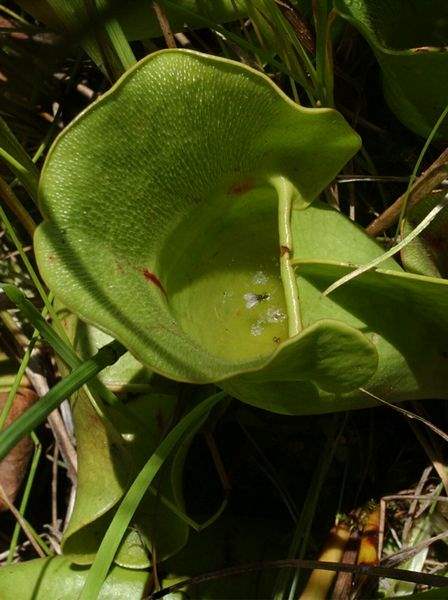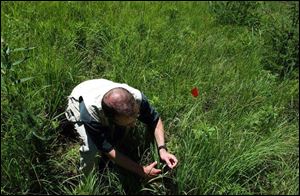
Grant will allow expansion
7/18/2003
Spongy soil provides the perfect nutrients for species like this pitcher plant.
lisa dutton / blade

Doug Pearsall of the Nature Conservancy's Michigan chapter studies the vegetation at the Grand River Fen.
HILLSDALE - Doug Pearsall stooped beside a young, glossy buckthorn and firmly yanked it out at its roots.
To the average eye, the leafy plant looked in place among the tall grasses and short shrubs of the Grand River Fen. But for Mr. Pearsall of the Michigan chapter of the Nature Conservancy, it was a known invasive foreign plant species in an environment the group has worked hard to protect.
Similar to the 76,000 acres of land the Nature Conservancy protects statewide, the 476-acre Grand River Fen is a haven for endangered animals and protected plants. The site, extending through northern Hillsdale County and southern Jackson County, soon will get a little bigger, thanks to a $375,000 federal grant.
“These wetlands tend to be very highly diverse. You get species that are not seen elsewhere,” Mr. Pearsall said, pointing out common fen plants such as pitcher plants and blazing stars. “They tend to be refuges for a lot of species that are endangered.”
State biologists long have recognized the ecological significance of the Grand River Fen. Located in low lands, a fen is the result of groundwater collecting at the base of hills made long ago during the glacial era, Mr. Pearsall said. Because the hills are made of silt, water drains through and collects in the saturated land.
The result, when undisturbed, is an area rich with certain types of vegetation and a haven for such insects as butterflies. Because it is a unique environment created under specific circumstances, fens are prized by biologists. The Grand River Fen in particular, Mr. Pearsall said, is a high-quality site.
That was why it was an easy choice for the recently awarded Recovery Land Acquisition Grant, enabling the conservancy to buy an additional 154 acres, said Don Morgan of the U.S. Fish and Wildlife Service. The money is part of $70 million in grants awarded in 29 states to support conservation planning and acquisition of habitat where threatened and endangered species thrive, he said.
The Grand River Fen, which soon will grow to 630 acres, was the only Michigan site selected.

Spongy soil provides the perfect nutrients for species like this pitcher plant.
Carrie Tansy, a biologist at the U.S. Fish and Wildlife Service, said fens are fragile areas that can be degraded easily by invasive species. The grant will allow the project partners - the Michigan Department of Natural Resources and the Nature Conservancy - to protect the fen and the land surrounding it.
“Even if you own this whole area, something can be built nearby, or a neighbor can plant an invasive species,” she said. “That's why it's so important to conserve a big area like that.”
The land the conservancy protects and manages is host to such globally rare species as the tamarack tree cricket, blazing star borer, and Powesheik skipper butterfly. The spongy ground provides the perfect nutrients for at least 100 plant species, Mr. Pearsall said.
To ensure the habitat does not become overgrown by trees or choked out by other species, the group will burn sections of the protected land in an attempt to keep a balance. But even though the burns are monitored and a part of the conservancy's management plan, they are done carefully so as to not disturb the wildlife, especially the several different types of butterflies seen fluttering about the boggy land.
The area is not open for public recreation, but biologists often are on the site inventorying plants and animals.
Together, with the help of money such as the recent grant, the Grand River Fen preserve has grown in size, giving the rare species that live there an opportunity to thrive.
“We never have enough funds to protect the lands we want to protect,” Mr. Pearsall said. “Formerly, the Nature Conservancy used to buy a piece of property and put a fence around it. Now we know we have to think beyond that.”